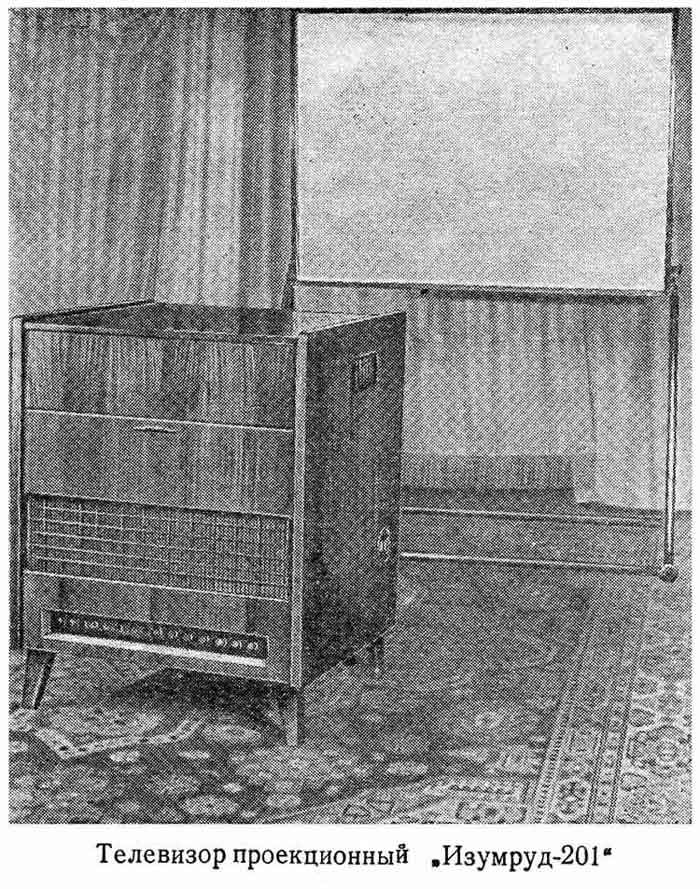TV receiver of color image `` Izumrud-201 ''.
Color TVsDomesticSince the 1st quarter of 1959, the Emerald-201 television receiver for color images has been produced by the Moscow Television Plant. "Izumrud-201" is a floor-standing projection TV for receiving color and black-and-white TV programs. Images of red, green and blue colors obtained simultaneously from three kinescopes using mirror-lens optical systems are projected onto an external reflective screen measuring 900x1200 mm, on which they are combined into one color image. This makes it possible to serve simultaneously 30 ... 40 spectators. The TV case is made in the form of a fixed floor stand, finished with valuable wood species. The TV speaker system consists of 5 loudspeakers located frontally (two types 4GD-1 and one VGD-1) and on the side walls of the case (two 1GD-9). This speaker arrangement creates a surround sound effect. The visual screen is made of sheet aluminum specially processed in such a way that the largest part of the light energy is reflected into the viewers' area. Color TV is quite complex and although the design was aimed at simplifying control, it requires some skill and knowledge to operate it correctly. Since 3 kinescopes are used simultaneously in TV, the number of controls naturally increases. The controls can be divided into 3 types. The main control knobs are located at the top of the TV, they make it possible to adjust the volume of sound, timbre at low frequencies, timbre at higher frequencies. There are also color control knobs with a color channel switch when receiving b / w broadcasts, a knob for adjusting the overall brightness, general focus and clarity knobs. The main knobs include the TV channel selector. The control knobs of the registration unit are needed to correctly align 3 images from 3 CRTs into a color image projected onto a reflective screen. The alignment block control knobs are divided into 3 groups. Each group contains controls for the horizontal, vertical, and horizontal image size. In addition, the TV has knobs for focusing blue and green images, correcting horizontal and vertical lines of blue and green. Each group of controls has a toggle switch to turn on or off any of the 3 picture tubes during alignment and initial adjustment. All control knobs are covered with a hinged cover. Auxiliary control knobs are located at the bottom of the case. These include adjustments for vertical size, vertical linearity, frame rate, horizontal frequency, horizontal size, blue and green signal levels, contrast, and color saturation. The controls brought out under the slot include: linearity vertically and horizontally, focusing, high voltage adjustment, flash amplifier mode, adjustment of the threshold for lighting blue, green and red. The Izumrud-201 TV, as well as other modern models, has systems: AGC - high-speed automatic gain control, APCG - automatic local oscillator frequency adjustment, AFC and F inertial automatic line frequency adjustment. There is a noise-immune sync pulse selector, high voltage stabilization, focusing current and others. The design of the optical system of the TV is the same as that of the Topaz black-and-white projection TV. The dimensions of the projection tubes for the Emerald-201 TV and their design are the same as those of the CRT used in the Topaz TV. The difference lies only in the color of the phosphors. To obtain a color image, the phosphors of the kinescopes should give, respectively, a blue, green and red glow. CRTs have spherical screens with a diameter of 6 cm. Types of attached CRTs: for blue color 6LK1A; for green color 6LK1I; for red color 6LK1P. The TV uses 36 tubes and 12 germanium diodes. Basic technical data: The sensitivity of the image signal channel is not worse than 100 µV. Sharpness in the center of the screen 400 lines. The band of reproducible sound frequencies in terms of sound pressure is not more than 60 ... 12000 Hz. Mains voltage 110, 127 or 220 V. Power consumption 400 W. TV weight 80 kg, screen 17 kg. A total of 225 Emerald-201 TVs were produced.